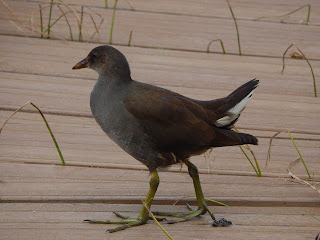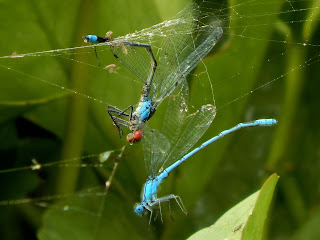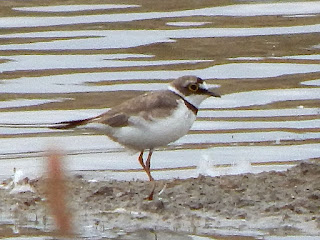 |
| Dersingham sundews. |
Our day began at Dersingham bog with the failed darter hunt, the weather at this point was far from ideal though I did at least finally catch up with a year first Migrant Hawker. A single Holly Blue butterfly was seen near to the car park while several Siskins flew over.
 |
| Mud is not in short supply at Snettisham! |
Having accepted that it was not going to be our day on the darter front we then moved on to Snettisham where a rare visitor from North America was the draw. Snettisham is far from being my favourite spot on this coast but as I'd never seen a Semipalmated Sandpiper before I couldn't not go. We arrived to find a fairly full car park and set out on the long walk past the row of almost shanty town type huts and past the various old gravel workings. A file of slightly dejected looking birders were traipsing back with negative reports and I began to feel just a little bit worried. Having got to the shingle it was obvious that the tide was out and providing acres of mud on which a hungry American visitor might feed.
 |
| Wall butterfly. |
Stopping to scope an area of mud we did find a smaller wader feeding amongst a group of Dunlins but after some deliberation decided that it was an adult Little Stint. Ahead of us, near the RSPB reserve there was another group of birders looking out across the mud. Catching up with them produced the hoped for news, the bird was in view and furthermore a chap was good enough to let me have a squint at it through his telescope. At this point I have to admit that I would struggle to tell a Semi-P from Little or in fact any other stint but the plumage of this bird was an exact match for the bird photographed yesterday. The bird's original finder was confident that this was THE bird and so too were the other birders brave enough to venture an opinion. Result!, my first new bird of 2018 and while nothing too dramatic from an aesthetic point of view it did make up for a previous dip way back when at Boddington Reservoir here in Northants.
 |
| Ruddy Darter and Red Admiral. |
Another highlight here was the sighting of a Wall butterfly which was my first in Britain for a few years. I used to see them around Corby and other areas in Northants but sadly this is a species that has retreated from most of the inland counties towards the coast or more upland areas. Not much else to report from here and we had another American wader in our sights so it was time to move on.
Titchwell RSPB reserve has been playing host to a Lesser Yellowlegs, a species that I have seen a few times before but still one that I was keen to see again. It didn't take too long to catch up with it and we enjoyed some good though fairly distant views. Not for the first time I got a few dodgy record shots and I'm happy to share one here with you. As is often the case Titchwell had rather a lot of interesting birds and we had a decent time sorting through the waders and gulls. A scan of one of the islands resulted in the discovery of two juvenile and one adult Mediterranean and one immature Little Gull. Highlights amongst the waders included at least eighteen Curlew Sandpipers, a juvenile Little Stint, a lovely sum plum Knot and several Spotted Redshanks. A few Bearded Tits were heard pinging but not seen.
 |
| Distant Yellowlegs, closer Avocet. |
I was hoping to see Willow Emeralds and we did spend a bit of time looking for them but once again failed to find an ode target today. We did manage to find a couple of Small Red-eyeds and a Brown Hawker and Emperor but apart from a few other common species not much else.
 |
| Moorhen. |
There was one final stop on the itinerary and that was at a heathland area to look for Nightjars. As related in an earlier post I've already seen them this year but I will never pass up on a chance to see these excellent birds. Settling down to wait for the show to begin we watched gulls heading over towards their roosts and I also saw a C17 flying westwards. Soon after the sun had set a bird began to churr, tentatively at first but more and more as it began to darken. As colour was leeched away by the gathering gloom we began to hear the flight calls of females. In my experience the window for seeing Nightjars is in that period about quarter of an hour before nightfall and it was the same today.
 |
| Juvenile Shelduck and Black-tailed Godwit |
Further calls put us on to our first view, just a brief glimpse of a female before she dropped below the skyline and out of sight but others soon followed. Another bird flew around me several times before settling on a path. All of us saw her before she took flight again though rather than disappearing she settled further along the trail and was joined by two others! We appeared to have stumbled across a family party and while the juveniles had clearly fledged they were not yet independent. For a further ten minutes we were treated to view of a total of four birds before darkness brought the spectacle to an end. Leaving to a chorus of more churring Nightjars and the occasional calling Tawny Owl we managed to get back to the car without putting our feet in any of the cow pats that decorated the paths, all in all a very satisfactory performance.
 |
| Bullocks providing potential pat hazard and C17. |
Any thoughts that our wildlife spotting day was over were to be proved wrong on our way home. A road closure in Peterborough forced a change of route and it was this that lead to a sighting of a Badger crossing the road just outside of Glapthorn village, what an end to what a day!














































